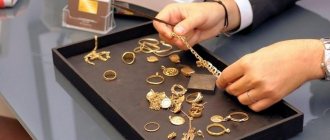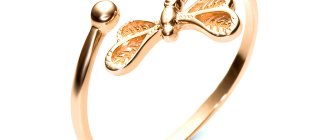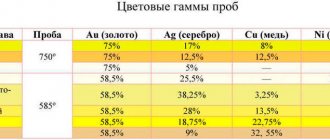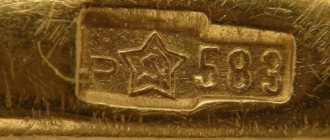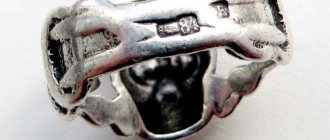Content
- 1 Sample systems 1.1 Metric sample
- 1.2 Carat hallmark
- 1.3 Spool test
- 1.4 Lot sample
- 1.5 Old English silver hallmark
- 1.6 Old Spanish silver hallmark system
- 3.1 Trial in the USA and Canada
Sample systems
The following sampling systems are available:
- metric
- carat
- spool valve
- lot
Metric standard
| add links to relevant standards |
The basis of the metric assay system is the number of milligrams of base noble metal in 1 gram (the percentage of pure metal in the alloy when adding a decimal point after the second digit) of the alloy being assayed. The sample value can also be considered as the number of parts by weight (fractions) of the base noble metal per 1000 parts by weight (fractions) of the alloy being tested.
The line of standard discrete fraction values was mainly established by recalculating the fractions of the carat sample system.
In the USSR since 1927, in the territory of the Russian Federation and the CIS countries, the metric system of samples has been adopted. Also used in France (with the adoption of the metric system of measures)[1], in Germany (since 1888)[2] and in countries that have signed the Convention on the Control and Marking of Articles of Precious Metals): Austria, Great Britain, Hungary, Denmark, Israel, Ireland, Cyprus, Latvia, Lithuania, the Netherlands, Norway, Poland, Portugal, Slovakia, Slovenia, Finland, Czech Republic, Switzerland, Sweden[3].
The following standards have been established for noble metals in Russia[4]:
- gold - 375, 500, 583*, 585, 750, 875, 916, 958, 999
- silver - 800, 830, 875, 925, 960, 999
- platinum - 585, 850, 900, 950
- palladium - 500, 850
*Allowed only for the manufacture of gold jewelry upon request from individuals.
Watches with carat and metric markings
Carat hallmark
The carat system is used in the USA and Canada. It was also used in Western Europe before the introduction of the metric system. In Ireland, both metric and carat hallmarks are used on the hallmark[5]. In the UK, the metric system has been used on hallmarks since 1973, but karat systems are allowed in descriptions[6]. Used only for gold (for silver, conventional names or metric hallmarks are used, for platinum and palladium - metric hallmarks).
The basis of the karat assay system is the number of carats of the base precious metal in 24 carats of the alloy being assayed.
For noble metals the following samples are used[7]:
- 9 carats - the weight of the noble metal is 0.375 of the weight of the alloy;
- 12 carats - the weight of the noble metal is 0.500 of the weight of the alloy;
- 14 carats - the weight of the noble metal is 0.583 of the weight of the alloy;
- 18 carats - the weight of the noble metal is 0.750 of the weight of the alloy;
- 21 carats - the weight of the noble metal is 0.875 of the weight of the alloy;
- 22 carats - the weight of the noble metal is 0.916 of the weight of the alloy;
- 23 carats - the weight of the noble metal is 0.958 of the weight of the alloy;
- 24 carats - the weight of the noble metal is over 0.999 of the weight of the alloy, that is, the metal in its pure form.
To indicate that the sample is karat, the abbreviations K, kt, C, ct can be placed after the number. In the USA and Canada, it is customary to distinguish English words by spelling. karat (sample unit) and English. carat (unit of mass).
To convert a carat sample to a metric value, the carat sample value should be divided by 24 and multiplied by 1000.
In Great Britain and Spain, in addition to the carat, the submultiple unit (English grain, Spanish grano)
) in ¼ carat, equivalent to 1 spool. There was also a unit of 1⁄16 carats (English quart).
Spool test
The spool test was introduced in Russia from the moment the testing of precious metals began, namely from May 1, 1798 [ source not specified 2021 days
] and operated until 1927.
The spool sampling system is based on the Russian pound, containing 96 spools. Similar to the European carat system, the spool mark in the designation corresponds to the number of precious metal spools in 96 spools (1 pound) of the alloy being hallmarked:
- 36 spools - the weight of the noble metal is 0.375 of the weight of the alloy;
- 48 spools - the weight of the noble metal is 0.500 of the weight of the alloy;
- 56 spools - the weight of the noble metal is 0.583 of the weight of the alloy;
- 72 spools - the weight of the noble metal is 0.750 of the weight of the alloy;
- 84 spools - the weight of the noble metal is 0.875 of the weight of the alloy;
- 88 spools - the weight of the noble metal is 0.916 of the weight of the alloy;
- 91 spool - the weight of the noble metal is 0.947 of the weight of the alloy;
- 92 spools - the weight of the noble metal is 0.958 of the weight of the alloy;
- 96 spools - the mass of the noble metal is over 0.999 of the weight of the alloy, that is, the metal in its pure form.
To convert the spool test to carat, the value of the spool test should be divided by 4. To convert the spool test to metric, the value of the spool test should be divided by 96 and multiplied by 1000.
Lot sample
The lot hallmark was in force in Germany for silver until the transition to the metric hallmark system (1888).
The lot system of samples is based on a stamp containing 16 lots that was in circulation in the Middle Ages among the Germanic, Scandinavian and Celtic populations of Europe and Britain. The lot hallmark in the designation corresponds to the number of lots of precious metal in 16 lots (1 mark) of the alloy being assayed:
- 6 lots - the weight of the noble metal is 0.375 of the weight of the alloy;
- 8 lots - the weight of the noble metal is 0.500 of the weight of the alloy;
- 12 lots - the weight of the precious metal is 0.750 of the weight of the alloy;
- 14 lots - the weight of the noble metal is 0.875 of the weight of the alloy;
- 16 lots - the weight of the noble metal is over 0.999 of the weight of the alloy, that is, the metal in its pure form.
To convert a lot sample into carats, the value of the lot sample should be divided by 2 and multiplied by 3. To convert the lot sample to metric, the value of the lot sample should be divided by 16 and multiplied by 1000.
Old English silver hallmark
In Great Britain, before the adoption of the metric system, the troy system was used for silver: the number of troy ounces and pennyweights (1/20 ounce) was indicated in 12 troy ounces of silver. For example: sterling - 11 ounces 2¼ pennyweight.
Old Spanish silver hallmark system
1=12 dineros=288 granos.
State hallmark
A heart in Stas Mikhailov’s repertoire is made of pure gold (and then only as a metaphor), but not a precious coin or a piece of jewelry. Gold and silver items are durable and strong only because they are made from alloys. True, the share of silver or gold in them often exceeds 95%. The content of precious metal in products is called breakdown. It is designated by a three-digit number, since it expresses the mass in 1000 parts of the alloy. Control over the sample is the prerogative of the state. All jewelry sold or sold in Russia - whether domestically produced or imported - is marked with an hallmark. Marking is not placed on:
- coins that have been issued;
- nuggets used in “jewelry”;
- state awards;
- gold and silver leaf;
- small cuts with precious metal on boxes, vases and other valuable items.
In Russia, a certain list of jewelry samples is valid:
375, 500, 583, 750 and 958 – for gold;
750, 800, 875, 916, 925 and 960 – silver;
500 and 850 – palladium.
The metal content must correspond to the regulated values; its share in the product cannot be less than the applied sample. In an imported product it may be slightly larger. Testing and marking are carried out by state testing inspections.
Sample designation
After determining the content of precious metal in the alloy, they are branded by applying symbols of the sample (the content of the main precious metal), the organization or person who carried out the determination of the sample, and other signs, for example, the manufacturer's mark.
The assay office is responsible for applying the sample. The sample indicates the code of the assay office, as well as the digital designation of the sample. In the jewelry business, the jewelry manufacturer is given a personal stamp - a name tag. A four-letter code that contains information about the year of manufacture of the product, the assay office in which the manufacturer is registered, and the code number of the manufacturer.
| It is necessary to clarify and disclose the topic of the hallmark system Add photographs and descriptions of marks both for manufacturers and for different samples and alloys. |
Trial in the USA and Canada
To designate a hallmark in the karate system, stamps containing the letter K after the hallmark value are used:
- stamps of the type “14K”, “18K” mean that the product is made of alloys of 585 and 750 samples, respectively;
- hallmarks of the type “22KGP” “23KGP” mean that the product is gilded using gold of the 916th or 958th standard, respectively - “KGP” here comes from the English “karat gold plated” - covered with so many carats of gold[8].
Test in Russia
Due to historical features, branding appeared in Rus' later than in other countries. The first Moscow brand - a double-headed eagle, accompanied by a date expressed in Slavic letters, dates back to 1651-1652. The first marks were not yet an indicator of sample in the exact sense of the word. The mark only indicated that the silver was no worse than the standard recognized by law, but the sample itself did not have a precisely defined standard. As a rule, high-quality gold was from the 83rd to the 85th standard and higher, which corresponded to the standard of “Lyubskie thalers” or “efimki” - imported coins that were melted down to make things. In the last quarter of the 17th century, the law also allowed a lower standard model - “levok”. A brand appeared - in the oval there was the word “Levok”.
In Russia, state hallmarking of products made of precious metals was legalized: silver - in 1613, gold - in 1700. Other metals were not branded and were not considered precious. Hallmark standards changed as necessary - for example, in 1711, hallmarks for silver items increased from 62 to 72 due to the susceptibility of low-grade silver to oxidation and tarnishing. In 1840, 56 and 94 samples of gold alloys were introduced[9].
For all cities in the 18th-19th centuries, the brands consisted of:
- from a stamp with the coat of arms of the city with or without a year in shields of various shapes;
- from a stamp with the initial letters of the first and last name - the “name” of the assayer;
- from the mark of the master who made the item, without indicating the year;
- from a stamp with two numbers indicating the purity, that is, the number of spools of pure silver or gold in a ligature pound.
Craftsmen, workshops, firms and factories were required to put their name stamps before presenting the products to the state assayer.
On January 1, 1899, on the basis of the new assay regulations for Russia, a uniform hallmark was introduced with the image of a female head in a kokoshnik in profile, directed to the left. Next to it were the initials of the manager of the assay district, and sometimes the numbers of the spool assay.
Since 1908, in all assay districts, new assay marks have been introduced with the image of a female head in a kokoshnik in profile, directed to the right, accompanied by a letter of the Greek alphabet - different for each assay district. The hallmark in the stamp is spool. The image of a woman's head in a kokoshnik changed depending on the method of branding or the period of application of the brand.
The sampling and marking system was changed in the USSR in 1927. Products made from other precious metals also began to be subject to hallmarking: platinum - since 1927, palladium - since 1956.
In 1927, the image of a woman’s head in a kokoshnik was replaced by the image of a worker’s head with a hammer. As part of the transition to the metric system of calculating measures, a new system is being created in which the sample is designated by the number of thousandths of gold in the alloy (it is still used to this day). The hallmark also contains the code of the assay office (a letter of the Greek alphabet).
On June 1, 1958, new hallmarks were introduced, which depict a convex sickle and hammer against the background of a five-pointed star. The hallmark inspection code begins to be marked with a letter of the Russian alphabet. Later, the image of the stamp remains unchanged, but its outline becomes cut out (replacement was made as the stamps wore out).
Later in the USSR, the system for marking hallmarked metal included 3, sometimes 2 marks: the manufacturer's mark, a numerical designation of the hallmark and an assay mark in the form of a five-pointed star in a frame. In the absence of a numerical designation, the shape of the stamp frame determined the parameters (including the sample) of the alloy being tested.
Since 1994, new hallmarks have been introduced, which are still in effect today. At the same time, the hallmarks of the “penultimate” sample (with a hammer and sickle) were in circulation along with the hallmarks of the “new” sample: for the 585th sample of gold - until March 2000, for the remaining samples - until April 2002.
The current stamp depicts a female head in a kokoshnik in profile, directed to the right. The code of the Assay Inspectorate is marked with a letter of the Russian alphabet (for each of the 18 Assay Inspectorates there is a different letter).
In the Russian Federation, stamps with the image of a female head in a kokoshnik are currently used for branding jewelry. Testing and hallmarking of jewelry and other household items made of precious metals in Russia is carried out by the Russian State Assay Office under the Ministry of Finance of the Russian Federation, established in accordance with Decree of the Government of the Russian Federation dated 02.02.1998 No. 106 “On the Russian State Assay Office”.
The procedure for testing and branding is regulated by Decree of the Government of the Russian Federation No. 643 of June 18, 1999 “On the procedure for testing and branding products made of precious metals.”
Deciphering the hallmark
The hallmark consists of two designations, which can be located either side by side or separately:
- the identification mark of our state is either a Soviet hammer and sickle in front and a star with five points in the background, which are still relevant as an assay mark, or a profile of a woman in a kokoshnik, turned to the right;
- sample sign.
Hallmark:
1 – Code of the State Assay Supervision Inspectorate 2 – Mark of the Assay Certificate 3 – Digital designation of the precious metal sample
Sketches of hallmarks on gold:
Sketches of an assay clamp for silver:
Sample determination methods
- Touchstone (testing of precious metals on a touchstone)
- Color shades of metals and alloys obtained by the action of assay reagents
- Chemical analysis using gold chloride, aqua regia, etc.
- Spectral analysis.
- Using hydrostatic weighing. The method does not always allow one to adequately and unambiguously determine the sample of a product, since alloys of the same sample (relative content of the main precious metal) may contain different components to achieve the required hardness, workability, color shades, etc. (see examples in the next section).
| The section is not completed. It is necessary to provide at least a minimal review of the methods for determining the sample. |
Alloy compositions and applications
The most common alloy is 585 gold; alloys of this sample can be of different colors depending on the quantitative ratio of non-ferrous metals contained in them. For example, if an alloy of 585-carat gold (58.5% gold) contains approximately 36% silver and 5.5% copper, the alloy acquires a green tint; at 18.3% silver and 23.4% copper - pink; at 8.3% silver and 33.4% copper - reddish. Depending on the alloy, it may have different melting temperatures and hardness; these alloys have good solderability.
958 gold alloys are fragile and therefore used in limited quantities. The alloy 958 is a three-component alloy, in addition to gold, it contains silver and copper, and is used mainly for the manufacture of wedding rings. The alloy has a pleasant bright yellow color, close to the color of pure gold. Very soft, as a result of which the polish does not last long on the product.
The alloy of 750 standard is three-component, contains copper and silver; in some cases, rhodium, palladium, nickel and zinc can be used in the form of an alloy. Color ranges from yellowish-green through reddish shades to white. The alloy lends itself well to soldering and casting and is a suitable base for applying enamels, however, when the alloy contains more than 16% copper, the color of the enamel becomes dull. It is recommended to use in the manufacture of products with thin relief knockout, filigree and settings for fragile gems and stressed diamonds.
375 gold alloy usually contains: gold 37.5%, silver 10.0%, copper 48.7%, palladium 3.8%. Used to make wedding rings.
For the manufacture of diamond jewelry, “white gold” is widely used, which contains:
- in an alloy of 585-carat gold - silver 23.7-28.7%, palladium 13.0-18% or nickel 17%, zinc 8.7%, copper 16%;
- in an alloy of 750-carat gold - silver 7.0-15.0%, palladium up to 14%, nickel up to 4%, zinc up to 2.4%, or nickel 7.5-16.5%, zinc 2.0 -5.0%, copper up to 15%.
The most common alloy is 875 silver. It is used to make decorations and tableware items. 916 alloy is used for the production of tableware with enamel coating; 960 standard alloy - for the manufacture of filigree products.
Alloys of platinum and palladium are used in jewelry in small quantities.
To protect against rapid oxidation and to improve decorative properties, silver and brass products are electrolytically coated with a thin layer of 999-carat gold (gilding), 999-carat silver (silver plating) or rhodium. The latter metal differs from the others mentioned in its greater hardness, as a result of which the polishing and color of the product are preserved much longer.
Platinum alloy is rarely found in modern jewelry; it has given way to white gold. Some jewelry uses a two-component 950 alloy, which contains copper and iridium in addition to platinum. The addition of iridium significantly increases the hardness of the alloy.
Palladium. The main palladium-silver alloys used in jewelry have silver grades of 500 and 850 (as they are the most technologically advanced for machining and are decorative). Palladium is already an independent metal for the production of jewelry. It has good prospects, but its price is growing every day, and in 2021 it has become more expensive than gold. Products made from palladium are no worse than platinum, and even benefit from being lighter. Palladium has a more intense dark color, better machinability, and the same resistance to tarnishing in air as platinum[10].
Where do fakes come from and how to distinguish them from the original
Fake marks are applied to jewelry for the purpose of profit. Thus, inferior products are sold at a higher price. Such fraud is punishable by criminal liability.
The biggest risk of buying a fake is purchasing gold second-hand. I advise you not to chase cheapness, but to buy jewelry in large retail chains.
What other fakes are there? Under the guise of gold, unscrupulous sellers can sell jewelry with the inscription, for example, 14K and Goldmult, Gold plated, Goldfeld. This means the base metal is plated with 14k gold.
Forewarned is forearmed. Is even a basic understanding of what a mark on a gold item looks like? to reduce the risk of buying a counterfeit to a minimum. Ask the seller for a magnifying glass or take a magnifying glass with you. Feel free to carefully examine the imprint on the jewelry.
Notes
- Métrologie universelle, ancienne et moderne: ou rapport des poids et mesures… — Jean-François-Gaspard Palaiseau — Google Books
- FeinGehG - Gesetz über den Feingehalt der Gold- und Silberwaren
- HMC - Role and Functions of the Hallmarking Convention (unspecified)
(unavailable link). Retrieved September 30, 2014. Archived August 31, 2014. - Decree of the Government of the Russian Federation of May 6, 2016 N 394 “ON SAMPLING, ANALYSIS AND HAMPERING OF JEWELRY AND OTHER PRODUCTS FROM PRECIOUS METALS”
- Hallmarking Service, Gold Hallmarking, Silver Hallmarking, Hallmark Guide, Irish Hallmarks
- https://www.gov.uk/government/uploads/system/uploads/attachment_data/file/210077/hallmarking-act-1973-with-palladium.pdf
- Samples of gold. Silver samples. Table and characteristics of gold and silver samples. Gold Unified Numbering System (UNS) - USA. Conversion of units of gold and silver content in the alloy. (Russian) (undefined)
.
Engineering reference book
DPVA.ru. - Products that have a silver plating protected by rhodium may not have any markings.
- A.V.
Polyakov. Sample - quality of precious metals // Collection of the Moscow Numismatic Society No. 7. - 2000. - Melnichenko T. A. Merchandising of jewelry and folk art goods: Textbook. - Rostov-on-Don: Phoenix, 2002.
